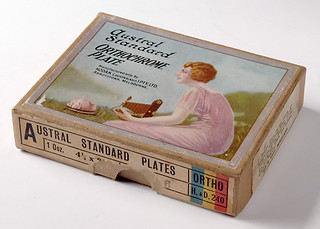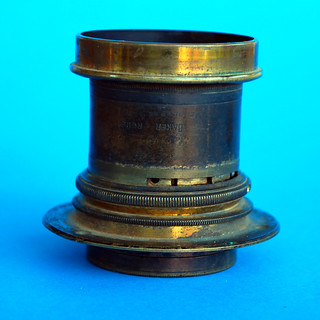Difference between revisions of "Baker and Rouse"
(Added text and reference) |
m (Added link) |
||
| Line 1: | Line 1: | ||
{{stub}} | {{stub}} | ||
| − | '''Baker and Rouse''' was a maker of photographic materials in Melbourne, Australia, from the late 19th century well into the 20th. '''Thomas Baker''' started the company as the '''Austral Plate Company''' in 1884. He formed a partnership with '''John Rouse''' in 1887; the company was renamed '''Thomas Baker and Company Laboratory''', then '''Baker and Rouse Australia Laboratory''', and finally in 1896 '''Baker and Rouse Pty Ltd.'''<ref>Introductory page to the [http://museumvictoria.com.au/collections/themes/2964/baker-rouse-collection?start=11 Baker & Rouse collection] at [http://museumvictoria.com.au/ Museum Victoria].</ref> In the 1890s the company had stores in Melbourne and Adelaide<ref>See inscription on this [https://www.flickr.com/photos/heritagefutures/4284276943 6 x 5 Rapid Symmetrical].</ref> and later also in Sydney and Brisbane.<ref>See inscription on this [https://www.flickr.com/photos/heritagefutures/10205343885 Wide Angle Rectilinear 4 ¼ X 3 ¼].</ref> In April 1905 Baker & Rouse took over the sole agency for Kodak materials in Australia.<ref>"Australians Behind the Camera" Sandy Barrie p.11.</ref> Baker and Rouse merged with [[Kodak|Eastman Kodak]] in 1908, both men remaining as directors of Kodak (Australasia) Pty. Ltd. | + | '''Baker and Rouse''' was a maker of photographic materials in Melbourne, Australia, from the late 19th century well into the 20th. '''Thomas Baker''' started the company as the '''Austral Plate Company''' in 1884. He formed a partnership with '''John Rouse''' in 1887; the company was renamed '''Thomas Baker and Company Laboratory''', then '''Baker and Rouse Australia Laboratory''', and finally in 1896 '''Baker and Rouse Pty Ltd.'''<ref>Introductory page to the [http://museumvictoria.com.au/collections/themes/2964/baker-rouse-collection?start=11 Baker & Rouse collection] at [http://museumvictoria.com.au/ Museum Victoria].</ref> In the 1890s the company had stores in Melbourne and Adelaide<ref>See inscription on this [https://www.flickr.com/photos/heritagefutures/4284276943 6 x 5 Rapid Symmetrical].</ref> and later also in Sydney and Brisbane.<ref>See inscription on this [https://www.flickr.com/photos/heritagefutures/10205343885 Wide Angle Rectilinear 4 ¼ X 3 ¼].</ref> In April 1905 Baker & Rouse took over the sole agency for Kodak materials in Australia.<ref>"Australians Behind the Camera" Sandy Barrie p.11.</ref> Baker and Rouse merged with [[Kodak|Eastman Kodak]] in 1908, both men remaining as directors of [[Kodak's international plants|Kodak (Australasia) Pty. Ltd.]] |
Revision as of 01:40, 6 October 2014
Baker and Rouse was a maker of photographic materials in Melbourne, Australia, from the late 19th century well into the 20th. Thomas Baker started the company as the Austral Plate Company in 1884. He formed a partnership with John Rouse in 1887; the company was renamed Thomas Baker and Company Laboratory, then Baker and Rouse Australia Laboratory, and finally in 1896 Baker and Rouse Pty Ltd.[1] In the 1890s the company had stores in Melbourne and Adelaide[2] and later also in Sydney and Brisbane.[3] In April 1905 Baker & Rouse took over the sole agency for Kodak materials in Australia.[4] Baker and Rouse merged with Eastman Kodak in 1908, both men remaining as directors of Kodak (Australasia) Pty. Ltd.

|
| Austral Plates (made by Kodak Australasia) image by Geoff Harrisson (Image rights) |

|
| Baker & Rouse 6 x 5 Rapid Symmetrical image by Dirk HR Spennemann (Image rights) |
Cameras
Austral falling-plate detective cameras have been seen in several sizes (No. 1A, No. 3 and No. 3A are listed at various websites)
Lenses
Baker Rouse imported lenses from European manufacturers, including French.[5]
- 6 x 5 Rapid Symmetrical [6]
French Origin
- Wide Angle Rectilinear 4 ¼ X 3 ¼ [7]
Notes
- ↑ Introductory page to the Baker & Rouse collection at Museum Victoria.
- ↑ See inscription on this 6 x 5 Rapid Symmetrical.
- ↑ See inscription on this Wide Angle Rectilinear 4 ¼ X 3 ¼.
- ↑ "Australians Behind the Camera" Sandy Barrie p.11.
- ↑ See inscription on this Wide Angle Rectilinear 4 ¼ X 3 ¼.
- ↑ See this lens.
- ↑ See inscription on this lens.
Links
- Austral No. 3A falling-plate camera marked for Baker & Rouse Pty Ltd, presumably dating it to 1908 or earlier, in sespquiped's Flickr photostream.
- Cameras including an Austral No. 3 at Aussiebloke
- Wide Angle Rectilinear 4 ¼ X 3 ¼ images with Nikon D800 (Antique Camera Simulator)